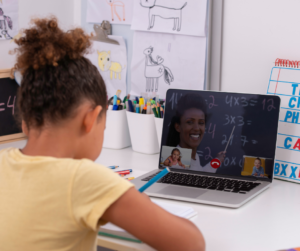Seven Remote Learning Tips to Boost Student Success
TODAY, WITH MONTHS OF REMOTE LEARNING UNDER OUR BELTS, WE’VE LEARNED A FEW THINGS.
Contributed by Christine Zanoni, PEP educational services coordinator; Denise Milner, special education supervisor, PEP Eastwood; and Lori Murphy, instructional coach, PEP Eastwood
The Sudden Switch to Remote Learning
 We’ve been teaching remotely for so long now it actually feels like the new normal. Nearly a year ago, when we walked out of our school buildings, planning on an “extended spring break” we had no idea that we were walking right into our own version of the “Twilight Zone.” And now, even as we return to a hybrid model, nearly half of our students’ time is spent in remote learning.
We’ve been teaching remotely for so long now it actually feels like the new normal. Nearly a year ago, when we walked out of our school buildings, planning on an “extended spring break” we had no idea that we were walking right into our own version of the “Twilight Zone.” And now, even as we return to a hybrid model, nearly half of our students’ time is spent in remote learning.
Today, with months of remote teaching under our belts, we’ve learned a few things. We’re more confident and capable in this new space. We certainly long for the day when we can all be in-person full time again, but in the meantime, here are a few of our favorite remote learning tips that make our current reality a little bit easier.
Seven Remote Learning Tips to Get the Most out of your Students
At PEP, we are strong supporters of the use of brain breaks, or regularly scheduled, short breaks that include movement and/or exercise during the school day. These interludes reduce stress, increase productivity and boost brain function – all of which are very important during remote learning. One important thing we’ve learned to improve their effectiveness: leave the camera on!
2. Strengthen your Relationships.
The relationships between the classroom staff and the child are key. Re-EDucation, the philosophy that serves as the foundation for much of PEP’s work, explicitly calls this out in its second principle: Trust between children and adults is essential. Make sure you are taking time to build these relationships. Take note of students’ interests and incorporate them into your lessons.
3. Use the Right Tools for the Job.
Just as you would in a classroom, it’s important to ensure you’re adapting your lessons appropriately. Use content differentiation to meet the needs of students on varying levels. In addition to the basic curriculum, use videos, music, and games as a means of engaging students who are ready for additional content. For those with low literacy, reading aloud can help them access the lesson.
4. Check for Comprehension.
Monitoring student progress in the remote environment is just as important as it is in person. Flexibility may be the key when it comes to continual formative assessment in remote learning. For some, writing a paragraph or drawing a picture may be most appropriate. In other cases, just having the student explain something back to you may be best. If necessary, meet one-on-one with the student to ask a few questions and gauge their understanding.
5. Routine, Routine, Routine.
Did we mention routine?This concept ties into another re-ED principle: Ceremony and ritual give order, stability, and confidence. Considering our lives have been upended by the pandemic, developing a consistent schedule, and sticking to it is paramount.
6. Acknowledge Big Emotions through Academics.
This past year has certainly provided a backdrop for some seriously big emotions. A global pandemic, racially motivated violence and an insurrection at the Capitol are all extraordinarily alarming and stressful. And that doesn’t even include the individual and family stressors our students face. There are many ways to incorporate these events into lessons, which can be healing. Tie events to science and social studies. A deeper, more comprehensive understanding of academics can help students navigate emotions. Bibliotherapy is another valuable tool to help students cope. Journaling can also be healing for students as they process disturbing event. And finally, do not forget to acknowledge the GOOD things that happen.
7. Find Some Joy in Each Day.
Yes, our world looks different through a Zoom camera but that doesn’t mean we can’t be intentional about this Re-ED principle. Games are a wonderful way to have some fun online with students. But even simply embracing your silly side can serve this purpose. Mix up a “feelings check,” for instance. Instead of having students report on an emotion, ask them what animal they are today and why. Weave a pun or a comic into your lesson. These little points of connection and fun are vital to teaching, even if it seems like they don’t meet one of the state’s learning standards.
Bring it All Together in a “Virtual Classroom”
There’s a lot to remember when teaching remotely. One model we have found helpful is a “virtual classroom.” With a little creativity, you can make your Zoom environment more than just a screen full of talking heads.
Some teachers at PEP have created slides of a pretend classroom they share with their students that includes links to and pictures of the kinds of things they would have in a regular classroom. In a cozy room with framed pictures on the wall, a rag rug, and a Bitmoji of the teacher, students can visit the art gallery of classroom art projects. They may see the class vision board, a fun question to answer in the chat box or the day’s schedule written on the board, for example. These visually interesting virtual classrooms make remote learning feel a little more like an authentic classroom with the added benefit of making it easier for the teacher-counselor to incorporate some of the tips above. (Thanks to teacher-counselors Jennifer Hebebrand and Kara Prevo for sharing their classrooms with us.)
At PEP, we are eager to return to the classroom and be with our students in person full time. We are happy to be able to be with them now, even in a part-time hybrid model. It helps us reinforce the relationships and connections we are building with our students. We’ve learned, too, that while in-person learning is best, there are also opportunities to make a difference in a remote environment. We applaud the creativity and ingenuity of teacher-counselors who are truly making the best out of a challenging situation. It’s this ingenuity that is making a difference and ensuring the continued academic achievement of PEP students even during a pandemic.
